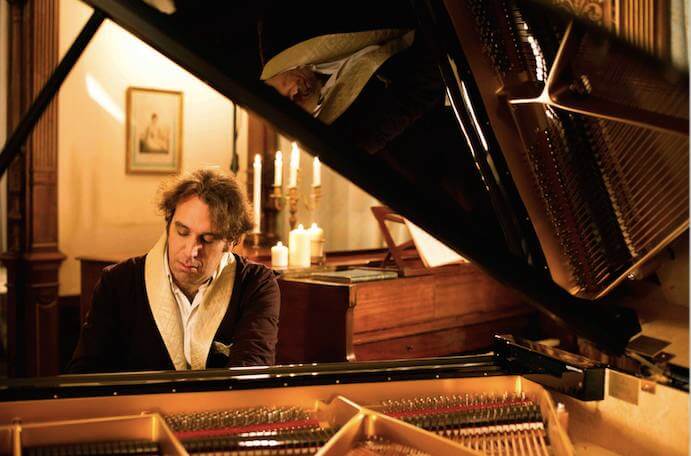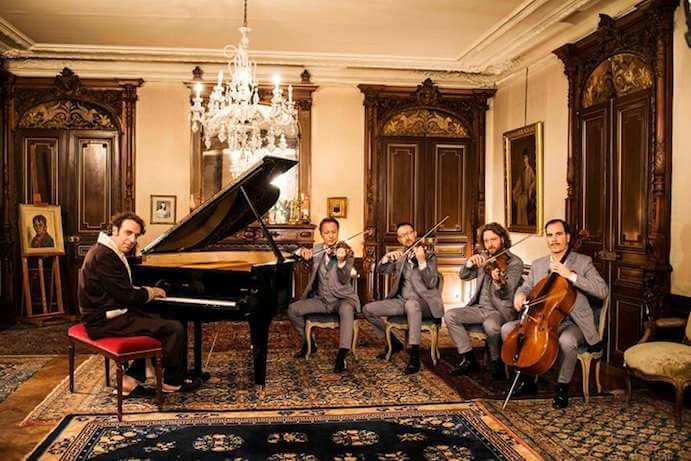Monday, April 13, 2015 marked the final of three consecutive sold-out shows by Chilly Gonzales & Kaiser Quartett in London. Performing at Barbican Centre’s newest venue Milton Court Concert Hall, and touring in support of his latest album, Chambers, Gonzo and his ragtag team of musicians set out to entertain, educate, engage, and provoke the audience in a way that no serious artist would ever dare attempt. At times he rapped, at times he antagonized Richard Wagner in anecdotal interludes, and at times he played Beethoven’s Fifth on bongos (an audience member mistook it for the theme of Hawaii Five-0). One could easily forget that this was a concert featuring a pianist and a string quartet plus drummer. Yet herein lies the genius, self-prescribed or otherwise, of Chilly Gonzales: he’s dead serious about his music, but the music is never just what it seems.
The night began with Gonzales strolling onto the stage in his usual garb – a satin bathrobe and slippers, for those unfamiliar – to play several unaccompanied pieces from Solo Piano (2004) and Solo Piano II (2012) including “White Keys” and “Kenaston.” The concert seemed on par for a program of leisurely instrumental music, as most listeners of the two aforementioned albums might expect. By the third song, however, Gonzales loosened into his signature style of highly physical piano playing, at one point striking single keys with his index finger like Schroeder in the presence of Lucy. Kaiser Quartett then appeared on stage, started tuning overtop of Gonzo’s performance, and finished doing so just in time to contribute a singular A-minor chord at the end of the piece. “Kaiser Quartett, ladies and gentlemen,” said Chilly Gonzales to a sea of applause and gentle laughter.

Chilly Gonzales– Photo by Alexandre Isard
He then began to address the audience directly, talking them through his set with an air of contempt for expectations of what classical music should be (and of classifications in general). Though his rants sometimes ended up nowhere (to which he willingly admitted), Gonzales always managed put the spotlight back onto the music, whether by demystifying its constructs (demonstrating different techniques across the various stringed instruments, then subsequently turning it into the basic rhythm of a song) or by giving music history a pop cultural slant (“Wagner was the Kanye West of the 19th century”). It might seem as though Gonzo talked too much and played too little, but the two aspects of his act worked perfectly hand-in-hand. If anything, his satirical banter actually encouraged the audience to pay closer attention to the music itself.
Milton Court made for a particularly well chosen setting to do so since the space, though designed like a concert hall with high ceilings and proper acoustics, felt more like an intimate jazz club. The sound of amplified strings filling the room were strange to the ears at first, given how seldom quartets of the non-electric variety are equipped this way, but it had to be done if Kaiser Quartett were to accompany Gonzales with a matching amount of punch. Perhaps the best moment of the concert, however, was its quietest one when even the stage lights were dimmed, leaving everyone in the dark to listen to a shimmering rendition of “Armellodie.” A soft spotlight appeared as the drummer (whose only task all night was to underline Gonzo’s grooves and rhythms) was finally allowed a solo, albeit on the trumpet.
Gonzales mentioned his preference for writing for people instead of their instruments, and this benefited their performance in every possible way. The rapport between each musician was apparent: they were clearly having fun, which in turn made the audience feel more invested in the experience as well. One could say that Gonzo is an expert at massaging the crowd – not to lower their expectations, per se, but to make them forget about expectations altogether. Despite the frivolity, Chilly Gonzales’ music remained very much the heart and soul of all matter. His songs, deceptively simple to the ears, were brilliantly arranged for live performance, which in turn spoke volumes about the depth and quality of the compositions themselves. It’s no coincidence that “Carnivalse” found its way into The Royal Conservatory of Music’s 2015 piano syllabus.




















